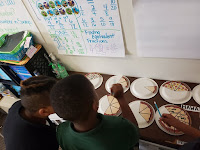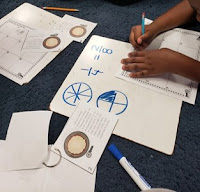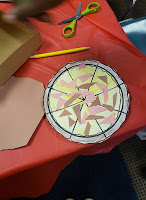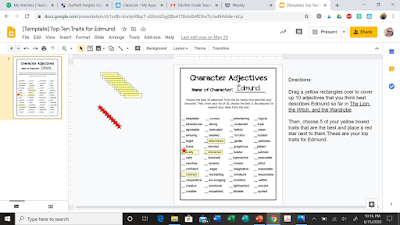Tuesday, August 3, 2021
Thursday, June 17, 2021
It's a Fraction Pizzeria! Simple Classroom Transformation
Everyone likes to have fun with a pizza party! Just the mention of pizza in the classroom increases the excitement of kids. So why not use something they love for your lesson content?
Imagine being able to take your students to a local pizza shop for a field trip to explore and review what you've learned about fractions. That would be AMAZING in a perfect world. But it's a possibility to bring the pizza shop experience to your classroom. That's what I LOVE about room transformations. I can bring any experience to my students and create a highly engaging atmosphere and lesson content for my students without leaving the school building.
Fraction Pizzeria was super fun and super simple to do. I used this at the end of my fraction unit for a review, and students were pretty much working independently in their groups throughout the event. I organized it into 4 different stations, and students rotated throughout the activities with their group.
Stations:
1. Order Up! - Ordering fractions from least to greatest (or greatest to least).
4. Build Your Own Pizza - Identify fraction of a set
Extra Station - Pizza Combinations - Convert fractions to decimals and percentages (higher level skills)
Monday, April 5, 2021
Identifying Character Traits in Reading
Character Trait Vocabulary
If your students are like mine, identifying character traits is tough. They can tell me if a character is nice or mean or helpful, but that's usually as far as they go.
So, I started focusing on this more and made an amazing discovery. No, it's not new, but it was eye opening, at least to me. It's a VOCABULARY issue!!! My students didn't understand what a lot of the more specific character traits meant.
Vocabulary development is a HUGE contributing factor in a student's literacy development. If a child can decode well and read fluently, it's not a guarantee that he/she is understanding what is being read. I took a couple years of German in high school and a bit in college. I can say that I was able to read some simple German words and texts, but I had no idea what those words meant. I didn't have the vocabulary background yet. And many of our students are like that, too.
We spent some significant time working through some character trait vocabulary. We used picture books (lesson ideas coming soon), examples from people we knew, historical figures, character trait growth mind set quotes... anything that would give my students an experience with a new character trait.
When my students had a better grasp on character trait vocabulary, I started using the below activity with novels and read alouds. This pushed them to not only be able to identify more specific traits but caused them to be able to analyze them.
Students have to identify 10 character traits that apply to a main character. Then, they have to narrow down their 10 traits to 5 best ones. This causes some great classroom discussion, as students have to prove or explain why a trait should be kept or deleted.
I usually do this as a class the first couple times to get students used to the activity and to encourage that important discussion. As students become familiar with this process, I let students split off into groups to complete. Then, when we come back together, groups present their top 5 traits. Many times groups will still have a variety of "top 5" traits, but their reasons are solid.
My students don't use "nice" and "mean" for their character traits anymore. And it's pretty amazing to see this transfer over to their writing. But that's for another blog post!
If you want this character trait activity, make sure to sign up for my newsletter It's yours for free! Just click the sign up button on my blog popup (or click the link below to sign up). And there's no worries about signing up for my newsletter - I promise not to spam your inbox! I'll only send relevant teaching ideas, inspiration, and FREEBIES. Promise!
Happy Teaching!
Martha
Tuesday, February 23, 2021
5 Fluency Practice Ideas for the Digital Classroom
We all know that students need to practice fluency to become
better readers. Now, as teaching has gone digital, we need to think of creative ways to hear our students
read. Here’s a list of ways you may want to try with your students to get some extra fluency practice in:
1. Readers' Theater - Yep! While this is a fun fluency activity in the classroom, it can definitely be done remotely! Most teachers have a way to interact with their students live, either via Zoom, Google Meets, or a variety of other platforms. Divide your students up into small groups (based on the number of parts in your script) and meet up! If you can get scripts to your students ahead of time, that’s perfect, but if you can’t, have the script up on your screen and SHARE YOUR SCREEN. It’s that easy. Your students will love the chance to read through the play together. (Check out the link below for a free Aesop's fable readers theater script!)
2. Voice Mail – If you have a school voicemail set
up where you’re able to retrieve your messages via your email, this is a
PERFECT way to listen to your students read. Have them call your school phone
number and read to you in a voice mail message. The time allowed in a message
is short, so you’ll get a small window of their reading. I would rotate
students on a weekly basis so you’re not sitting listening to all 30 kids in
one day. But this can be a doable (and fun) option for you!
3. Phone/Devise recording – Most phones and devices
have recording options. Students can record themselves reading and send you an
attachment. Students can upload their file and send it to you in Google
Classroom or another platform that you may be using. Also, many of the parent
communication apps that are used (we use ClassDoJo) have a student portfolio
section, which would be a great place to upload these files!
4. Fluency Timers – Timers always make a task more
fun! Give them a passage with a timer. Tell them to read at a normal speed
until the timer runs out. I have a bunch of hourglass timers in my classroom.
If you are using digital timers, have them set the timer and read until time is
up. Students can read to parents and/or other family members, babysitters,
pets, stuffed animals, a favorite plant or object outside… the sky is the
limit!
5. Fluency Charts – No matter how you have your
students practice, have a chart for them to fill out each time they do. Keep it
simple – have them fill in the date, the title of the text they read, and how
many words they read during their time. You may wish to number the words before
giving students their passages so they don’t have to count.
Grab your FREE Aesop's Fables Readers' Theater Script from The Owl Spot! (Grades 3-5)
Here's your FREE Aesop's Fables Readers' Theater Script for primary grades!
Interested in finding more helpful and practical teaching ideas? Sign up for my newsletters below!
I love AudioBooks!
I guess I wouldn't be a good (or great) reading teacher if I didn't love reading, right? The problem is, I find it hard to read for enjoyment during the school year. If I actually find time to read, I'm so tired that I fall asleep while trying to get through a book.
Enter the discovery of audiobooks.
I never thought I'd love listening to an audiobook, because it's "just not the same" as reading it for myself. It took a change in schools and a long drive to get me to try them out, and now I'm hooked. The danger now is getting so lost in the story that I forget to get off at the right exit on the highway. Thankfully, that hasn't happened (yet).
There's so many options for audiobooks. I think my first exposure was using Cracker Barrel's CD book rental on a long distance drive. (Did you know they have that? You can pick out a book on CD at the counter, listen on the road, and return at any other Cracker Barrel. It's wonderful!)
Listening on the drive to and from work has allowed me to get my fix of new YA books, historical fiction, and a plethora of other ones that I probably wouldn't have gotten a chance to read.
Another AMAZING use of audiobooks is using them in your classroom. Yep! I made this connection last year (I swear, sometimes it takes me a while to figure things out). To read about how I used the audio version of Refugee by Alan Gratz, read here... In a nutshell.. my students were HOOKED on this book, even though they were struggling readers. Having the audio playing while they read their own copy of the book let them "hear" the characters, understand so much more of the story, and gain valuable listening skills that are needed for life.
So, where do you start?
There's a couple options. I tend to stick with the first two in the list, but I included a few others that you may want to consider.
1. Audible through Amazon - (I have no kickback by mentioning this here, by the way.) They give a couple options for when and how many books you can access. While I was still teaching in person, I got a new credit every month, which usually lasted for my long drives. Now that I'm teaching from home, I've backed off and only get a new credit every other month. Saves money.
Plus Side: Once you purchase the book, it's yours. If you start reading and decide you don't like it, you can return it and get your credit back. So, when I use my purchased version of Refugee, I can use it every year in school when I teach this novel.
Down Side: Cost
2. Hoopla - You access the app through your library system. They offer free audiobooks (they also have ebooks, music, and movies) on a rental agreement, just like the library. You have the book for 30 days, and then it automatically returns.
Plus Side: Free access and you don't have to remember to return the books! It's automatic.
Down Side: You don't keep the books. Also, there isn't the large variety to choose from as you would on other sites.
Other apps that are out there, but I haven't tried. I am an Audible fan, and I tend to stick with what works for me. But you may find one of these to be a good match!
3. Google Play - similar to Audible. Purchase as needed. I don't think they have a subscription base platform.
4. LibriVox - access free classic audiobooks. They also have paid audiobooks if you live in the US.
5. Libby - another library-based site for renting audiobooks. Libby was created by OverDrive.
6. Audio Books - seems like a similar set up to Audible.
7. Kobo - similar to Audible and Google Play Books. You can choose the $10/month subscription. This is a little cheaper than Audible. I might need to look into this one!
8. Kindle - I have used this one, as well! While Kindle is more known for their ebooks, they also have audiobooks. Instead of having to choose one or the other, though, you can purchase the ebook and add the audio for a fraction of the cost. Kindle allows you to switch between the ebook and the audio while keeping your place. This is great if you want the best of both worlds!













